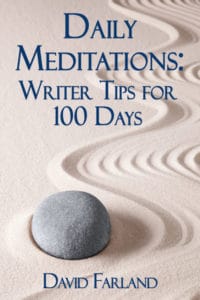As lead judge to the world’s largest competition for sci-fi and fantasy short fiction, David Farland can tell you exactly how to write a short story that’s a winner.
The key is to keep it short and powerful—but for authors who typically write novels, “short” is a dirty word. So how do you write a powerful story in under 10,000 words? Rest assured it is possible and it doesn’t have to be terrifying.
A short story must convey everything that a full novel does, just in a fraction of the words. The shape and movement of the story are conceived of and crafted in the same way as a novel. Once you realize that a short story is just a novel with few words, it’s easier to see how it might come together.
Key ways to cut back on words are to whittle everything down by asking, “What’s most important?”
Consider characters, the number of scenes you need to tell the story, your protagonist, where you’ll start your story and how you’ll end it. These are all the most important places to focus in order to ensure that you not only hit the emotional beats that make for a great story, but also keep the word count to a minimum.
Enroll in David Farland’s Writing Mastery workshops today!
Tips for Writing a Short Story
The best way to narrow the expanse of your story is to limit the number of characters and scenes used to tell your story.
- Keep to one or two viewpoint characters. The more characters that you introduce, the more complex their relationships become, the longer your tale will stretch. As a novelist, you might want to create a dozen interesting characters, but developing a well-rounded character takes time and adds a lot to your word count.
- Plan on a handful of scenes, at most. A movie or book will often have between 70 and 100 scenes, and in each one, you have to describe the locations. So when describing your world, look for ways to keep it intriguing without spending pages and pages on description.
- Every story needs to have a protagonist, in a setting, with a significant conflict. In a short story, make that one significant conflict your main focus, and don’t go looking at too many secondary conflicts. Two or three minor conflicts suffice. Algis Budrys, a fantastic writer and a longtime critic for the Chicago Sun Times, used to say that a short story should focus on the single most important incident in your character’s life. If the conflict doesn’t rise to that level, it’s probably not significant enough.
Enroll in David Farland’s Story Puzzle online workshop today!
How to Pack Short Story Punch
- Start in the middle of action. Most authors will try to build toward a main conflict, but you should get to the middle of it as soon as possible.
Ernest Hemingway once wrote a letter to his agent, saying, “I just wrote a short story about a man whose son gets killed in the war. He goes out to a bar and gets drunk, then hangs himself.” Now, if you’ve read his famous short piece “A Clean, Well-lighted Place,” you’ll recognize that Hemingway doesn’t tell us in the opening that the protagonist has had his son killed. Instead, he’s just drinking, and as he does so, his thoughts spiral down into the abyss. The tone of the story hints at previous incidents. If your character has had a bad hair day and an argument with her psychiatrist, it may not be . . . worth writing. You might want to start the story later.
So look at each scene that builds toward your climax and ask yourself, “Does this need to be here? Does it really serve its function?”
I find that scenes that build toward a powerful conflict work if they do the following:
1) add startling new insights to the character or situation,
2) twist the story in unexpected directions.
3) Help us understand the character’s motivations.
- Just as you can truncate the opening of a short story, you can also truncate the end. In Hemingway’s story, he doesn’t tell us that the protagonist goes home and hangs himself. Again, the tone implies the ending.
- Look for a powerful conclusion, one that is emotionally moving or intellectually stimulating. That’s the centerpiece for your tale—the reason for its existence. Some authors insist that the story end happily, and I admit that I like happy endings. But powerful is better than happy.
- When you’re done, trim it back. Cut every single excess syllable in the story so long as it doesn’t adversely affect your plot, your characters’ voices, or the tone of the story.
In other words, keep it short and powerful.
Subscribe to David Farland’s #WritingTips for the web’s best writing advice delivered right to your inbox.




